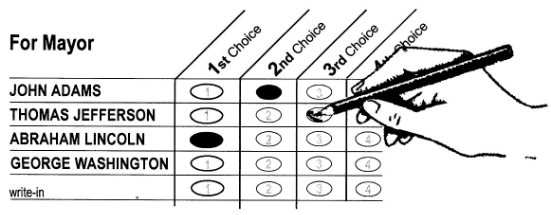7.2 Computer Assisted Counting
Systems using more complex ballots, such as the United States, can take longer to count. Optical scan ballot tabulators can be used to help speed up the process. Electronic tabulators are more efficient and more accurate than manual counting (Thomas et al., 2022). These machines can be hand-fed, where election workers feed the ballot into the tabulator at the time of voting, or they can be batch-fed, where election workers can feed multiple ballots into the machine for counting.
Ontario was the first Canadian province to adopt optical scan ballot tabulators (Smartmatic, 2023). In America, over 90% of counties use some type of electronic tabulation (Verified Voting, 2025). Machine tabulators use Optical Mark Reading (OMR) technology, allowing the machine to easily recognize simple ballot markings (ACE Electoral Knowledge Network, n.d.-e).

Ballots that require voters to write in preferences or use alpha-numeric characters to rank candidates are not suited for OMR tabulation technology.
Rejected Ballots
 Counting Delays
Counting Delays
On election night, media outlets report preliminary vote totals as they are published by election officials. These results offer an incomplete picture – one that can change quickly as new votes are added to the tally. Variation in counting procedures can give the impression that a candidate is leading and is overtaken by another candidate. This apparent increase in vote totals as more votes are counted is known as ‘the gain’ (Foley, 2013).
Americas Blue Shifts
Since the 2000 election, there has been a partisan difference in propensity to cast an absentee ballot, with Democratic voters being more likely to vote by mail (Allen, 2024). As a result, differences in counting procedures can give the impression that the republicans (represented by the colour red) are leading early in the evening – sometimes called a red mirage, only to see the lead disappear as more absentee ballots are counted – sometimes called a blue shift (Foley & Stewart, 2020). The shift is a product of differential counting procedures across states, specifically related to the counting of mail ballots. Florida, for example, allows counting of mail ballots prior to election day, whereas Minnesota does not (NCSL, 2024).
Further Reading
If you’d like a more detailed explanation of the Blue Shift, read What Blue and Red ‘Shifts’ Looked Like in Every State
It is important to remember that election returns reported by the media are unofficial tallies of votes counted (Curiel et al., 2021). After the initial round of counting, preliminary results must be compiled and verified. That’s what we will look at next.

